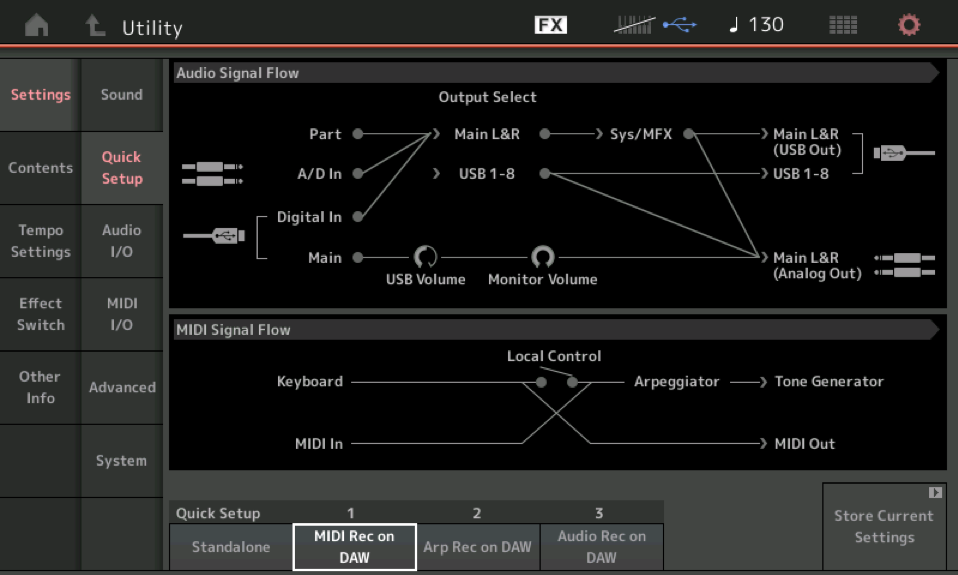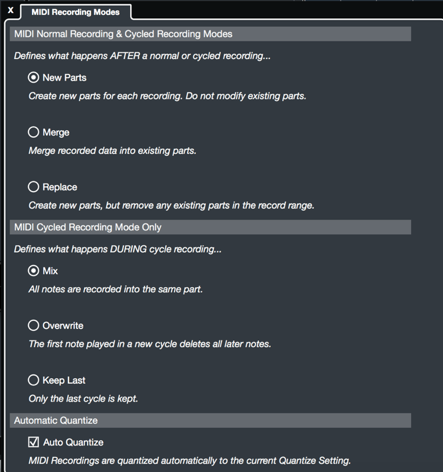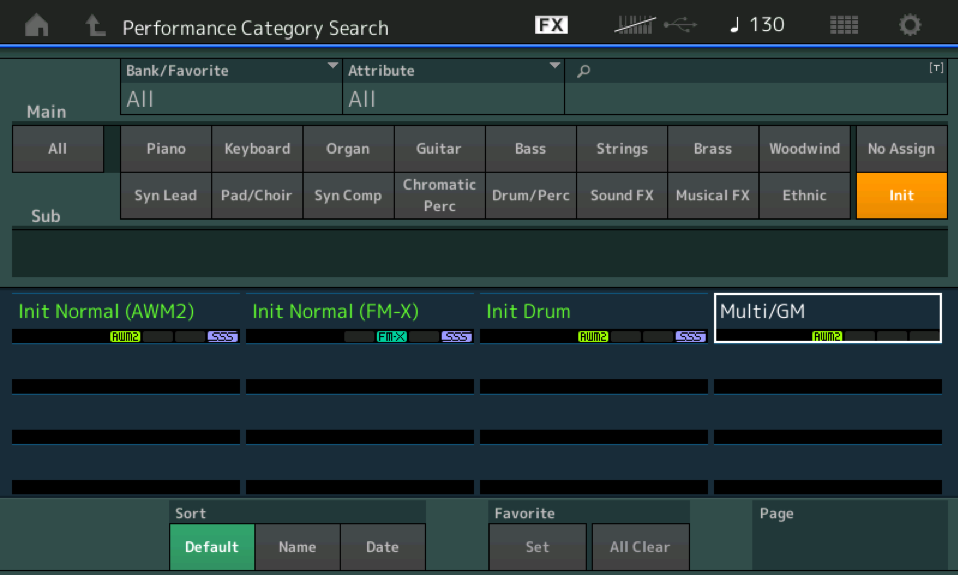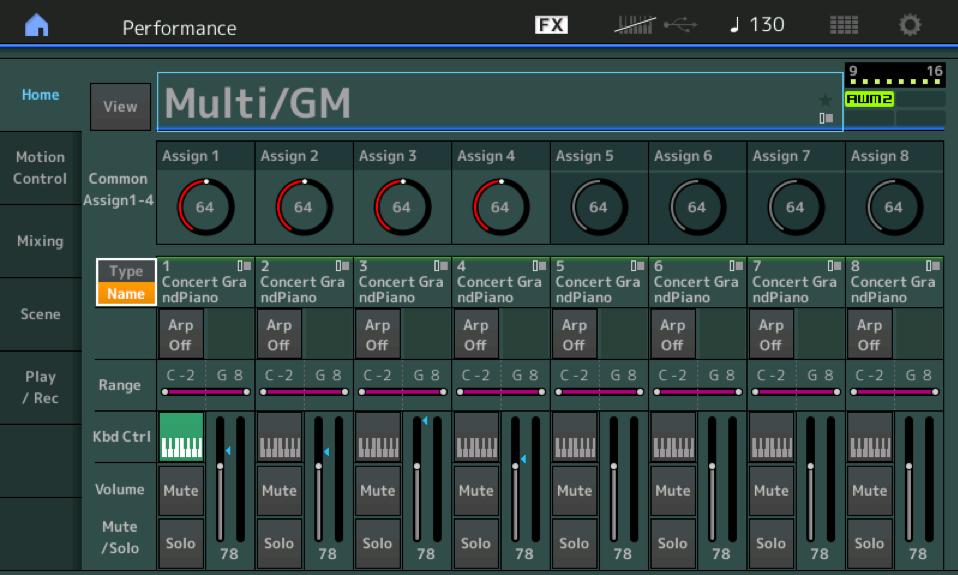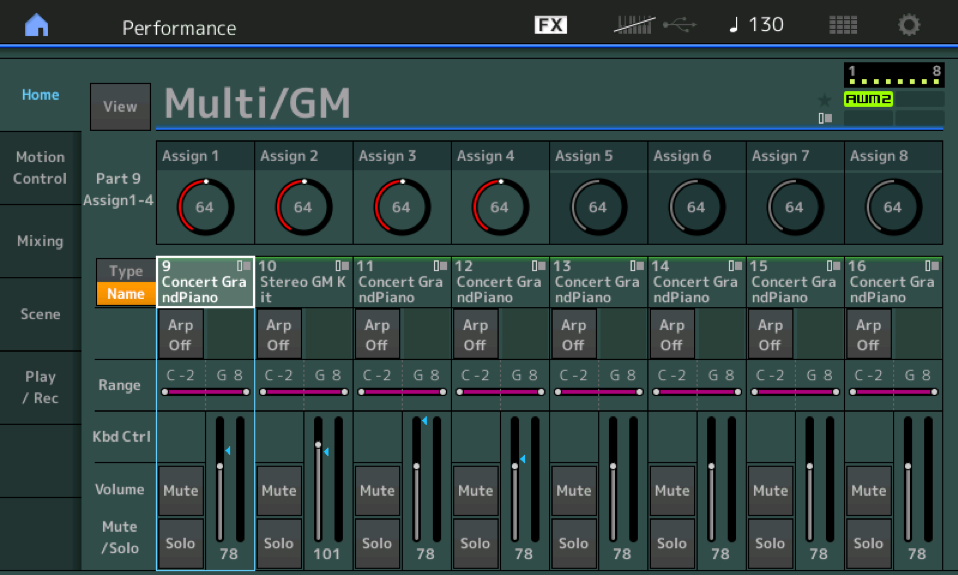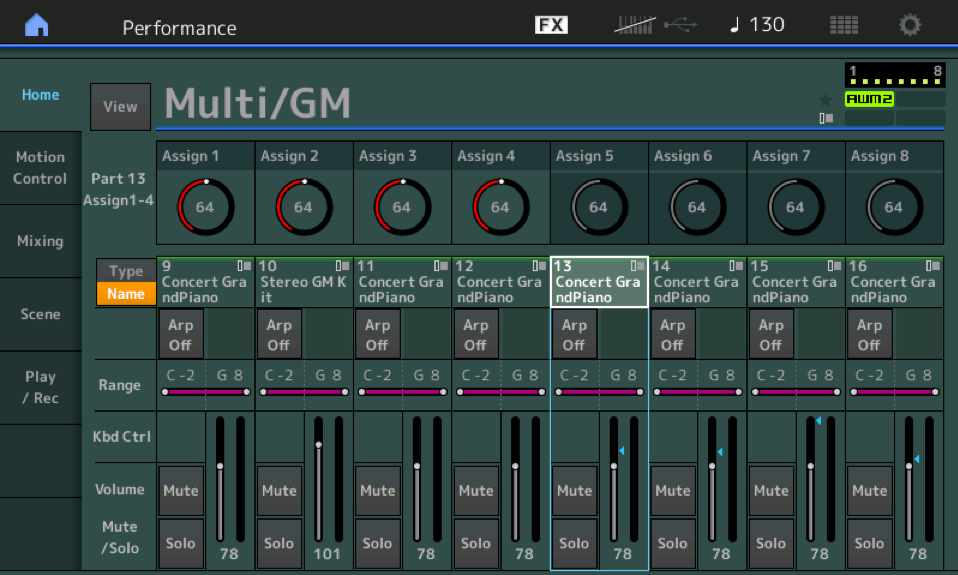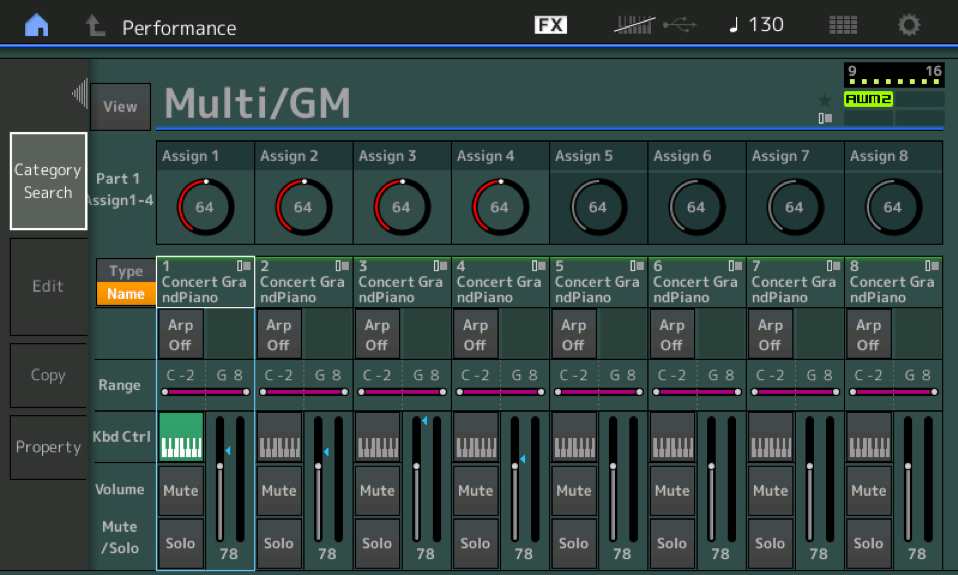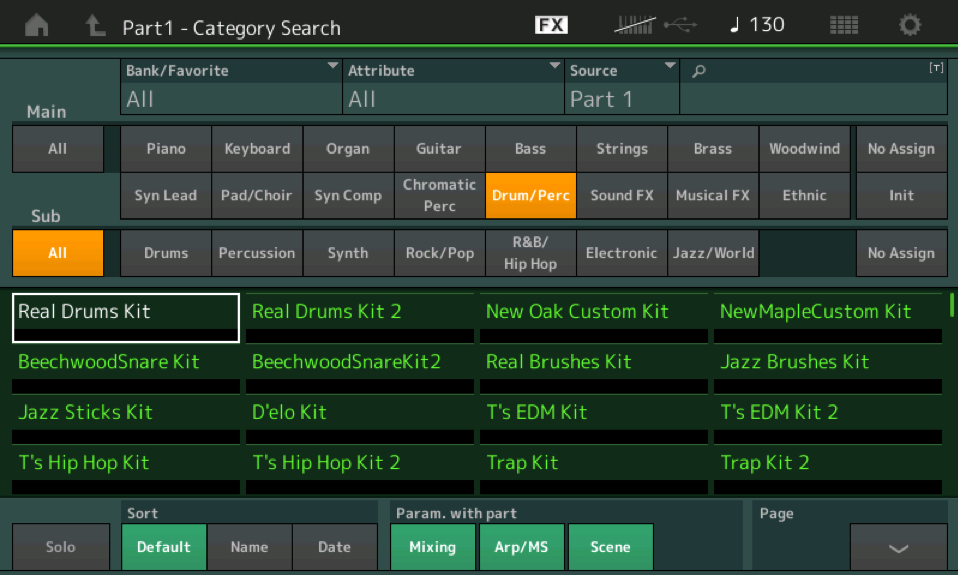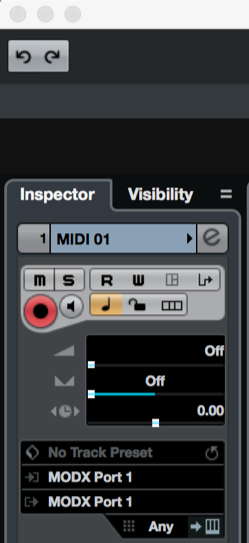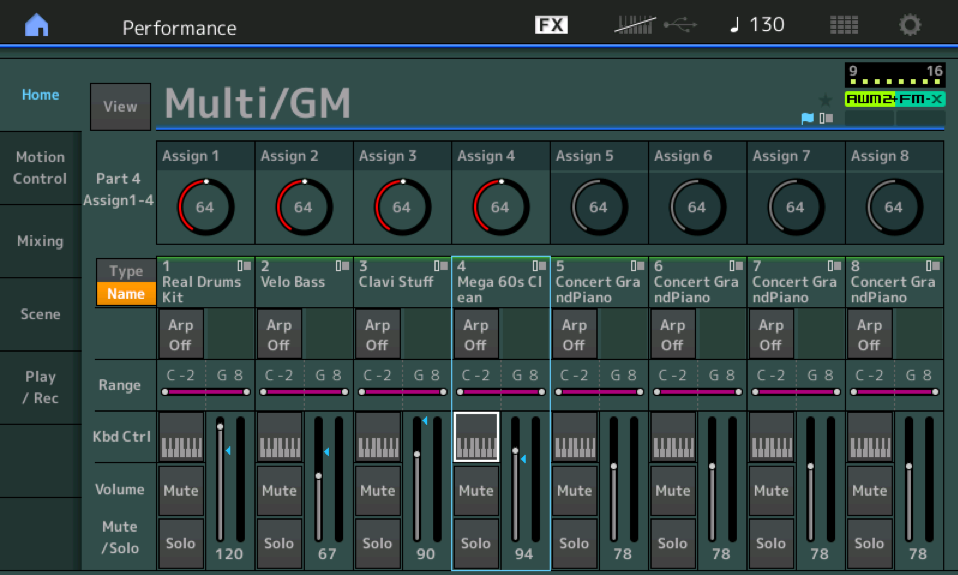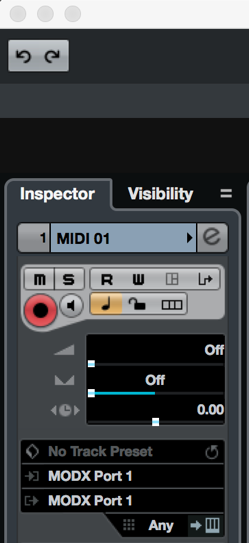Let’s start with a basic MIDI example where you are recording Drum, Bass, Keyboards, Guitar, etc., to Cubase – one after the other (traditional). This workflow will be most familiar to those used to working in the Motif/MOXF series, and will work very much like working in PATTERN Record mode. We will use the ability of Cubase to Cycle record (Loop while recording) to build as many as sixteen tracks of MIDI data. In this workflow we will be selecting SINGLE PART programs (only) and we will be using the QUICK SETUP Template called: “MIDI RECORD ON DAW”:
- This MODX “Quick Setup” template will make eight important MIDI parameter settings concerning MODX when selected.
- Press [SHIFT] + [UTILITY] to jump to the QUICK SELECT screen.
- Touch Quick Setup 1: “MIDI Rec on DAW”:
As soon as you touch Quick Setup the template parameters are changed. Local Control is turned off, MIDI Sync is set so MODX will follow Cubase, among the other setting preparing to record MIDI to a computer.
Workflow Example #1: Cubase – PATTERN Mode-like Recording
- Setup the Left/Right Markers in Cubase to define an eight-measure region. (1.1.1.0 through 9.1.1.0)
- Set the CYCLE icon (purple) to activate loop recording.
- Set “MIDI Cycle Record Mode” attributes on the TRANSPORT to MIX and set Auto Quantize, if desired. Check it out below:
- On the MODX Press [CATEGORY] and Select “Init”:
- Select “Multi/GM”. This Performance template has sixteen Parts, each on a separate MIDI channel. You can see Parts 1-8 or Parts 9-16:
- To view PARTS 9-16: Press [SHIFT] + Slider Select [1-4] to select Part 9. Check it out below:
- Press [SHIFT] +
- Slider Select [5-8] to jump to Part 13:
Power Tip
When working in a “Multi/GM” Performance setup, where there is a PART in each slot, turn the KBD CTRL icon OFF for each Part – this will allow you to address just the currently selected MODX Part.
Set the Markers in Cubase to outline the number of measures you’d like to Cycle (loop) recordi. Let’s say you want to do 8 measures. This would mean you have a Left Marker at measure 1 and the right Marker at measure 9. Click on the CYCLE icon (purple) on the Cubase Transport:
Set the attributes for your MIDI recording on the Cubase Transport bar… Set “Auto Quantize” if that is what you desire, and set it so each cycle allows you to “Mix” new data with existing data as it loops around.
I suggest that you select several instruments first before you ever hit record, this way you don’t have to break your concentration to pick sounds. Besides you can always change your mind and substitute for anything later (it’s MIDI, after all).
For example, in the “MULTI/GM” Performance I will select the following four Parts:
- Real Drums Kit
- Velo Bass
- Clavi Stuff
- Mega 60s Clean
Touch the TYPE/NAME box on PART 1.
An overlay pops in from the left with an option to “Category Search”:
Touch “Category Search”.
The SEARCH field allows you to search for any PART, from any Performance; you can use the “Bank”, “Attribute” and “Source” items to narrow your search. “Source” can be set to any single Part.
Shown below is the DRUM/PERC Search Results:
Create one MIDI track in Cubase, set to receive MIDI IN from “MODX 1”, set to MIDI OUT to “MODX 1”, and set to the OUT Channel = ANY:
So…Let’s regroup and check out what we’ve learned!
The Track Inspector in Cubase will give you the information about the current track. You can see that the INPUT is set to “MODX Port 1 (or could be set to “All MIDI Inputs”) and you can define the “MIDI Inputs” in the STUDIO SETUP > MIDI PORT SETUP screen.
The MIDI OUTPUT is set to my MODX PORT 1.
The MIDI OUT CHANNEL is “Any” which determines how Cubase will pass the data THRU (echo back to the MODX):
We have selected “Any” so that the incoming MIDI is echoed back OUT on the channel it comes in on.
This “Any” Channel setting for the MIDI OUT is a key. It allows Cubase to THRU the data back Out on the channel on which it comes in. How it will work: The Drums [Part 1], when selected on the MODX, will trigger data as CH1, the Bass in [Part 2] will trigger data as CH2, the Clavi sound [Part 3] will trigger data on CH3, and the Clean Guitar sound [Part 4] will trigger data on CH4.
LOCAL CONTROL is OFF; in order for the MODX Tone Generator to respond to your key press, a complete circuit must be maintained. The key presses travel OUT via USB-MIDI, arrive at this active MIDI Track, which echoes the data back to the MODX Tone Generator on the MIDI channel that the data was generated on.
The cool thing is this…
I don’t have to worry about the channel number – I just set the instrument sound in the PART and when I select it to play I will be transmitting on that MIDI channel. I don’t have to worry about switching Tracks, I’m using just one track initially that will capture all the data.
MODX Port 1 represents 16 MIDI channels. Now I can just concentrate on playing.
Later, we can have Cubase divide the data (DISSOLVE PARTS) to separate tracks for viewing/editing. While I’m recording, I don’t even want to deal with creating a track for each Part that I play. Once I select a PART [1]-[16] in the MODX, Cubase is ready to record it.
Dividing data out to separate tracks for MIDI data is a convenience for viewing and editing the data, and we can deal with that when we have data for viewing and editing.
On MODX, we are using the Quick Setup #1 = MIDI REC on DAW:
- Setup the Cubase CLICK and Count-in; Set the Tempo*… And go.
*Both can be set on the Cubase TRANSPORT. Go to TRANSPORT and click on “Transport Panel”.
See the Cubase documentation (HELP) for details about CLICK options and Tempo Maps.
Recording is exactly like recording to Pattern mode in a MOTIF XF/MOXF:
- You can use the front panel PART SELECT [1]-[16] function to directly select the Part you want to play…
- Press [PART SELECT-MUTE/SOLO] and with “1-8’ selected, touch ‘1’.
And you don’t have to hit STOP to switch to the next instrument, or even setup or arm another track, or route via a MIDI channel or any of that. Use the RIGHT CURSOR to move to PART 2 and continue playing. Get your musical ideas down while you’ve got on your musician hat.
Basically, this is how I build my rhythm section tracks – or the basic core ensemble that will play throughout the composition. For the next “section”, set the left Marker at 9 and the right Marker at 17… and so on.
Extra Credit: Splitting the data (DISSOLVE PART)
If I need to edit the data of one of the tracks you can use the MIDI pull down option: DISSOLVE PARTS _ by channel… This separates the four Parts to four tracks for easier viewing.
In Cubase, go to MIDI > DISSOLVE PARTS > ‘by channel’.
Once I have my rhythm section tracks in a reasonably workable state… I render them as audio. (The process of transferring the MIDI data to Audio: simply playing back the MIDI data and recording the Audio Output of the MODX to an Audio Track… rather than utilizing the MODX hardware to recreate the data, I will now have an audio waveform documenting these musical parts. This allows me to reuse the MODX hardware for more MIDI data.
This allows me to play along with them while I free my MODX for more creative duties. I keep the MIDI Tracks in a muted folder -so that if later I change my mind about what’s there, I have my original data.
I’ve found that working with the rhythm section and rendering audio via the 8 studio bus outputs is awesome workflow… Parts can be routed to discreet outputs; Parts can be assigned to use their own dual Insertion Effects… And depending on the Project I can even route each drum on its own discreet output to its own audio track (future article)! Heaven!
Now that the rhythm section is rendered as audio, I’m free to use anything I want on my MODX. Because we have MIDI clock, adding things, after-the-fact, like arpeggios, tempo driven effects and LFOs, even replacing earlier Parts, is totally possible.
Finally, everyone will find their own “best method” of working! Scores of variations exist. Spend time learning the available tools in Cubase AI. If Pattern mode style recording is your workflow of choice, you can setup Cubase AI (free download) to function this way, as described above. Those with Cubase Pro have more options as there is an ARRANGER – PLAY ORDER feature that makes Chaining Sections, placing/creating fill-ins, and the overall task of arranging your data, a breeze. Enjoy!
Want to join the conversation about this lesson? Post your comments on the Forum here.

